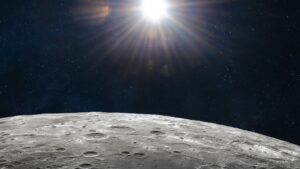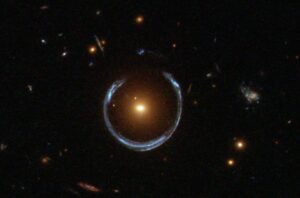After a complex, years-long game of connect-the-celestial-dots, astronomers announced a majestic discovery this month: 62 new moons orbiting around Saturn.
The ringed planet is the solar system’s second-largest, and now it’s far and away the most orbited. With newly discovered moons as small as 2.5 km across (or one-third the length of Hollywood’s Walk of Fame, as Space.com put it), we now know 145 confirmed moons orbit its gaseous surface.
With all those forces roiling the planet’s vast bulk, it’s tough to picture what must be happening to the liquids far below its gaseous envelope. But if there was any way to stand on the edge of the planet and gaze upward, you’d see a dizzying swarm of spinning moons. Some are singularly huge: Titan, the biggest, is larger than the planet Mercury.

Major moons of Saturn, to scale. Photo: Kevin Gill, NASA/JPL-Caltech/SSI/CICLOPS
That’s in addition to Saturn’s many rings, which are basically churning debris fields.
So amid all that, how did scientists on Earth manage to parse out moons the size of neighborhoods? The answer boils down to a proven method, applied in painstaking detail over the course of years.
Spotting lonely rocks in a vast cosmic sea
Edward Ashton, a postdoctoral fellow at the Academia Sinica Institute of Astronomy and Astrophysics, led the research. Perched on top of Hawaii’s Mauna Kea, using the Canada-France-Hawaii Telescope (CFHT), his team employed a method called “shift stacking” to first identify tiny objects, then confirm their orbits.

The Canada-France-Hawaii Telescope. Photos: Wiki Commons, University of Hawaii
To spot Saturnian satellites too tiny to glimpse in a single frame even through the notably enormous CFHT, you’d need multiple images (to magnify brightness). The problem is, everything’s moving. Shift stacking solves this by snapping a sequence of exposures, then “shifting” them all so that the pixels on each one correspond to the location of the target object.
Stack those on top of each other, and you have a visible signature of a celestial body that would otherwise be too faint to see.
That still doesn’t mean what you’re looking at is a moon, though. Which leads us to why Ashton and his team’s research, which began in 2018, is only concluding now.
‘Which dot belongs to which puzzle?’
To meet the definition of a moon, an object must orbit something larger than itself (that is not a star). Could these relatively small rocks that the team spotted zipping past Saturn be asteroids? Sure. The only way to figure out for sure would be to shift stack them repeatedly, each time they showed back up.
The total data set involved two years’ worth of frame-by-frame, three-hour shoots by the CFHT, according to Space.com.
If forcing it into coherence sounds complicated, it was.
“Tracking these moons makes me recall playing the kid’s game Dot-to-Dot, because we have to connect the various appearances of these moons in our data with a viable orbit,” Ashton said in a statement. “But with about 100 different games on the same page, you don’t know which dot belongs to which puzzle.”
Better him than me.
‘Irregular moons’: Satellite errata
Each one of the 62 newly confirmed moons falls under the “irregular” category. These moons can orbit their home planets distantly, or even in retrograde — opposite to the planet’s rotation. That’s because they did not form in orbit around the planet, but instead fell into its gravitational field from elsewhere and became captured.
(Saturn hosts three main groups of irregular moons: the Inuit group, the Gallic group, and the dense Norse group. Each new moon falls into one of these three groups.)
As of the new count, Saturn has 121 irregular and 24 regular moons. That places it back on top of the solar system’s “most moons” list, which Jupiter briefly took over earlier this year. The count could change at any time — depending on who’s fastest at connecting the dots.






